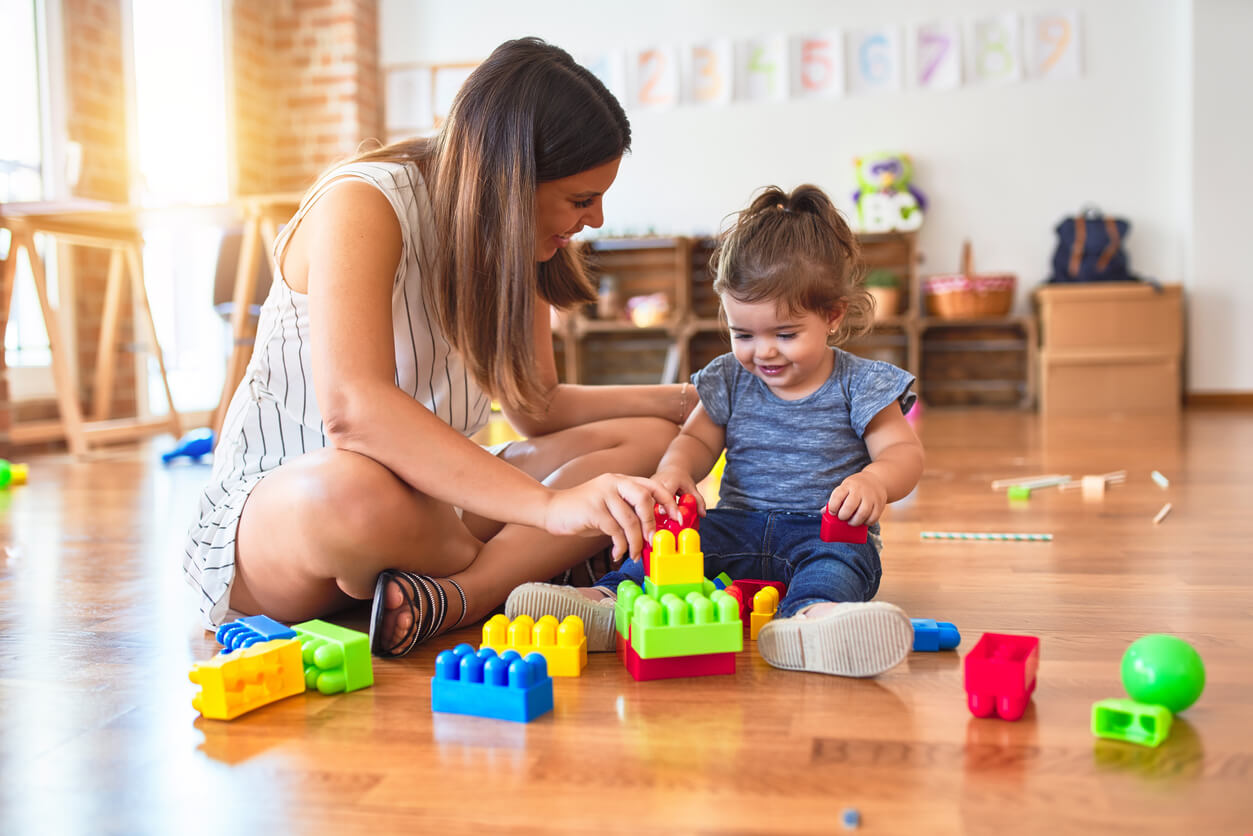Teach Your Children to Cultivate Happiness: 6 Important Keys


Written and verified by the psychologist Elena Sanz Martín
All parents want their children to be happy. They want to see them grow, succeed, and become optimistic, motivated, and capable of fulfilling their dreams. However, these qualities aren’t innate and don’t develop by chance. Children have to acquire and practice them. And for that, they need guidance from adults. If you want to contribute to this goal, we’ll show you how to teach your children to cultivate happiness.
The key lies in understanding that each person has a decision about how they feel, and that our moods can’t depend on what happens around us. We know that life isn’t always easy, and your children, like anyone else, will face times of adversity. These may arouse fear, sadness, anger, or frustration in them, but if they have the necessary tools, they’ll be able to stay afloat.
Happiness returns to a fixed point
Before offering you some guidelines, we want to tell you why it’s crucial to teach children to cultivate happiness. We assume that well-being depends on how well we’re doing. However, it has been shown that happiness in each person has a fixed point around which it’s usually maintained. This psychological mechanism is known as hedonistic adaptation and accounts for the ephemeral effect of events in our lives.
For example, one could imagine that a person who wins the lottery would feel much happier than they were before; and that a person who becomes a paraplegic would experience much greater discomfort than before their accident. However, it has been observed that a series of processes operate in the brain that, in a short time, cause both people to return to a level of happiness similar to the one they had before these great changes.
From this, we can learn that it’s not positive to leave our happiness in the hands of chance. On the contrary, it’s our job to cultivate the attitudes and habits that allow us to establish a good level of well-being on a daily basis.
How to teach your children to cultivate happiness?
Here are a series of guidelines and exercises that you can put into practice to help your children cultivate their own happiness.

1. Forge a solid self-esteem
A main and essential task is to teach children to cultivate a good relationship with themselves. This implies that they’re able to see each other, talk to each other, and treat each other with love; that they listen to their emotions, accept their mistakes, and always encourage each other to continue. Teach your child to love, respect, and be self-compassionate. In this way, you’ll lay a wonderful foundation for them.
For this, it’s important to talk to them as you’d like them to talk to themself. Remember that this internal dialogue is shaped by what they hear from their parents. Also, you can encourage them to practice positive affirmations every day and urge them to enjoy time alone to do their favorite activities.
2. Accept yourself unconditionally
Often, unhappiness arises when we don’t fully accept ourselves, compare ourselves to others, and seek to fit into the molds and expectations of others. To prevent this from happening, teach your child to know and accept themself unconditionally.
This means helping them see what their strengths and qualities are and to understand their needs. There are children who are very creative and others who love sports; there are some who are very sociable and others who prefer small groups. All options are valid, and the important thing is not to force ourselves to be a way we aren’t.
If your child knows and accepts themself well, they’ll be able to take advantage of their talents, be proud of who they are, and choose the options and possibilities that best suit them. That way, he won’t feel self-conscious or forced to be different. This may be especially relevant for children who are neurodivergent, but it applies to everyone.
3. Take charge of your happiness
Big changes only bring a short-lived increase in happiness, but it has been shown that if they require effort, they bring longer-lasting benefits. For example, getting better at a skill, such as playing chess, is more satisfying than buying a toy. So, teach your children to take charge of their own happiness by setting goals that motivate them and that they’ll work for.
4. Practice gratitude

Gratitude is one of the strengths stated from positive psychology that contribute the most to well-being. Practicing it can help children to remember how many blessings they enjoy in their daily lives and to be more aware of them. To do this, each day you can review three things you’re grateful for that make you feel good.
Examples can range from a hug from mom to a sunny day to a good time spent with a best friend. Also, being aware of how much we’ve improved and not forgetting the achievements we’ve made.
5. Regulate emotions
Life won’t always be nice and easy. Inevitably, there will be adverse moments and challenges to overcome. We can’t prevent our children from experiencing sadness, disappointment, fear, or anger, but we can prepare them for it. For this reason, it’s important to work on emotional intelligence, teach them to understand their emotions, name them, and regulate them appropriately.
There are many exercises and techniques that can be used for this. From breathing exercises to a calm corner or the emotional thermometer. Be sure to accompany your child when they’re feeling down, validate their emotions, and show them how they can deal with them when they come up.
6. Stay optimistic and motivated
Finally, to teach your children to cultivate happiness, try to help them develop an optimistic attitude. This is the force that will propel them to trust in the future and move forward, even when the present isn’t very favorable. Also, teach them self-motivation and self-confidence. With this, they’ll be able to take the reins and move on to a better situation when something goes wrong and they won’t feel helpless and incapable in the face of adversity.
Children who learn to cultivate happiness are safe
As you can see, this task isn’t simple and requires important and constant work with the little ones. However, it’s a way to ensure their long-term well-being. With the above guidelines, you’re preparing your child to face life, enjoy the good things, and navigate difficulties with simplicity. Instilling these attitudes and tools from infancy is giving them the tools with which they can continue to build their happiness forever.
All parents want their children to be happy. They want to see them grow, succeed, and become optimistic, motivated, and capable of fulfilling their dreams. However, these qualities aren’t innate and don’t develop by chance. Children have to acquire and practice them. And for that, they need guidance from adults. If you want to contribute to this goal, we’ll show you how to teach your children to cultivate happiness.
The key lies in understanding that each person has a decision about how they feel, and that our moods can’t depend on what happens around us. We know that life isn’t always easy, and your children, like anyone else, will face times of adversity. These may arouse fear, sadness, anger, or frustration in them, but if they have the necessary tools, they’ll be able to stay afloat.
Happiness returns to a fixed point
Before offering you some guidelines, we want to tell you why it’s crucial to teach children to cultivate happiness. We assume that well-being depends on how well we’re doing. However, it has been shown that happiness in each person has a fixed point around which it’s usually maintained. This psychological mechanism is known as hedonistic adaptation and accounts for the ephemeral effect of events in our lives.
For example, one could imagine that a person who wins the lottery would feel much happier than they were before; and that a person who becomes a paraplegic would experience much greater discomfort than before their accident. However, it has been observed that a series of processes operate in the brain that, in a short time, cause both people to return to a level of happiness similar to the one they had before these great changes.
From this, we can learn that it’s not positive to leave our happiness in the hands of chance. On the contrary, it’s our job to cultivate the attitudes and habits that allow us to establish a good level of well-being on a daily basis.
How to teach your children to cultivate happiness?
Here are a series of guidelines and exercises that you can put into practice to help your children cultivate their own happiness.

1. Forge a solid self-esteem
A main and essential task is to teach children to cultivate a good relationship with themselves. This implies that they’re able to see each other, talk to each other, and treat each other with love; that they listen to their emotions, accept their mistakes, and always encourage each other to continue. Teach your child to love, respect, and be self-compassionate. In this way, you’ll lay a wonderful foundation for them.
For this, it’s important to talk to them as you’d like them to talk to themself. Remember that this internal dialogue is shaped by what they hear from their parents. Also, you can encourage them to practice positive affirmations every day and urge them to enjoy time alone to do their favorite activities.
2. Accept yourself unconditionally
Often, unhappiness arises when we don’t fully accept ourselves, compare ourselves to others, and seek to fit into the molds and expectations of others. To prevent this from happening, teach your child to know and accept themself unconditionally.
This means helping them see what their strengths and qualities are and to understand their needs. There are children who are very creative and others who love sports; there are some who are very sociable and others who prefer small groups. All options are valid, and the important thing is not to force ourselves to be a way we aren’t.
If your child knows and accepts themself well, they’ll be able to take advantage of their talents, be proud of who they are, and choose the options and possibilities that best suit them. That way, he won’t feel self-conscious or forced to be different. This may be especially relevant for children who are neurodivergent, but it applies to everyone.
3. Take charge of your happiness
Big changes only bring a short-lived increase in happiness, but it has been shown that if they require effort, they bring longer-lasting benefits. For example, getting better at a skill, such as playing chess, is more satisfying than buying a toy. So, teach your children to take charge of their own happiness by setting goals that motivate them and that they’ll work for.
4. Practice gratitude

Gratitude is one of the strengths stated from positive psychology that contribute the most to well-being. Practicing it can help children to remember how many blessings they enjoy in their daily lives and to be more aware of them. To do this, each day you can review three things you’re grateful for that make you feel good.
Examples can range from a hug from mom to a sunny day to a good time spent with a best friend. Also, being aware of how much we’ve improved and not forgetting the achievements we’ve made.
5. Regulate emotions
Life won’t always be nice and easy. Inevitably, there will be adverse moments and challenges to overcome. We can’t prevent our children from experiencing sadness, disappointment, fear, or anger, but we can prepare them for it. For this reason, it’s important to work on emotional intelligence, teach them to understand their emotions, name them, and regulate them appropriately.
There are many exercises and techniques that can be used for this. From breathing exercises to a calm corner or the emotional thermometer. Be sure to accompany your child when they’re feeling down, validate their emotions, and show them how they can deal with them when they come up.
6. Stay optimistic and motivated
Finally, to teach your children to cultivate happiness, try to help them develop an optimistic attitude. This is the force that will propel them to trust in the future and move forward, even when the present isn’t very favorable. Also, teach them self-motivation and self-confidence. With this, they’ll be able to take the reins and move on to a better situation when something goes wrong and they won’t feel helpless and incapable in the face of adversity.
Children who learn to cultivate happiness are safe
As you can see, this task isn’t simple and requires important and constant work with the little ones. However, it’s a way to ensure their long-term well-being. With the above guidelines, you’re preparing your child to face life, enjoy the good things, and navigate difficulties with simplicity. Instilling these attitudes and tools from infancy is giving them the tools with which they can continue to build their happiness forever.
All cited sources were thoroughly reviewed by our team to ensure their quality, reliability, currency, and validity. The bibliography of this article was considered reliable and of academic or scientific accuracy.
- Brickman, P., Coates, D., & Janoff-Bulman, R. (1978). Lottery winners and accident victims: Is happiness relative? Journal of Personality and Social Psychology, 36, 917–927.
- Sheldon, Kennon M., and Sonja Lyubomirsky. “The challenge of staying happier: Testing the hedonic adaptation prevention model.” Personality and Social Psychology Bulletin 38.5 (2012): 670-680.
- Wood, A. M., Froh, J. J., & Geraghty, A. W. (2010). Gratitude and well-being: A review and theoretical integration. Clinical psychology review, 30(7), 890-905.
This text is provided for informational purposes only and does not replace consultation with a professional. If in doubt, consult your specialist.








